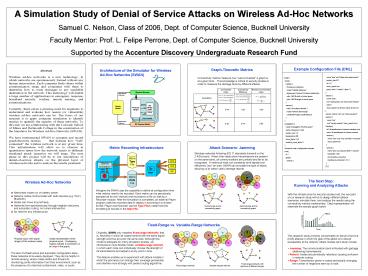SWAN - PowerPoint PPT Presentation
1 / 1
Title:
SWAN
Description:
We gave the SWAN user the capability to define at configuration time what ... Originally, SWAN only modeled fixed-range networks, that is, networks in which ... – PowerPoint PPT presentation
Number of Views:110
Avg rating:3.0/5.0
Title: SWAN
1
A Simulation Study of Denial of Service Attacks
on Wireless Ad-Hoc Networks Samuel C. Nelson,
Class of 2006, Dept. of Computer Science,
Bucknell University Faculty Mentor Prof. L.
Felipe Perrone, Dept. of Computer Science,
Bucknell University Supported by the Accenture
Discovery Undergraduate Research Fund
Architecture of the Simulator for Wireless
Ad-Hoc Networks (SWAN)
Graph-Theoretic Metrics
Example Configuration File (DML)
name "app" use
"tstapp.sess-app-session" packet_size 512
iat 1.0 show_report true
peer netid 1 hostid 2 iface 0
session name "aodv use
"routing.aodv_sim.swan-aodv-session"
netid 1 show_report true show report at
the end session name "net" use
"net.ip-session" session name
"arp use "net.arp-session" show_report
true interface id 0
identification of network interface card
netid 1 identification of wireless network
session name "mac" use
"mac.mac-802-11-session" show_report
true session name
"phy" use "phy.phy-802-11-session"
bandwidth 11e6 accumulative_noise
true interference_threshold -111.0
model arena mobility
nodes are stationary model
"mobility.stationary" deployment "random"
uniform distribution xdim 1500 width of
virtual space ydim 1500 length of virtual
space network netid 1
wireless network 1 model
"network.fixed-range" cutoff 350 signal
cutoff distance propagation
model "propagation.friis-free-space"
carrier_frequency 2.4e9 system_loss 1.0
temperature 290 noise_figure 10.0
ambient_noise_factor 0 network node
configuration example host id 1
graph session
Connectivity metrics measure how well-connected
a graph isat a given time. This knowledge is
critical to security studies inorder to measure
the damage done by different attacks.
Connectivity Index
ConnectivityEfficiency
Randics ConnectivityIndex
Physical Process
read terrain features
Description
Protocol Graph
Terrain Model
OS Model (DaSSF Runtime Kernel)
memory
time
0.44
1.00
4.26
run thread
Host model
read terrain features
RF Channel Model
3.62
0.20
0.44
Attack Scenario Jamming
Metric Recording Infrastructure
Wireless networks following 802.11 standards
transmit on the2.4Ghz band. When other
destructive transmissions are presenton the same
band, all communications are jumbled and fail to
berecognized. A malicious node can constantly
emit signals andeffectively jam an area. SWAN
can simulate this type of attack,allowing us to
obtain useful damage reports.
Metric Type File
EPS
SWAN simulation
JPG
metric values
GIF
Metric Data File
Player
Wireless Ad-Hoc Networks
Recorder
The Next StepRunning and Analyzing Attacks
We gave the SWAN user the capability to define at
configuration time what metrics need to be
recorded. Each metric can be periodically sampled
(at its own interval) and recorded to a file on
disk by a Recorder module. After the simulation
is completed, an external Playerprogram uses the
recorded data to display it according to a chosen
format. Player and Recorder use the Type File to
determine the formatting of records in the Data
File.
- Networked nodes run on battery power.
- Network nodes communicate with radio devices
(e.g. Wi-Fi, Bluetooth). - Nodes can move around freely.
- Networks form spontaneously through neighbor
discovery and automatic routing no human
intervention. - No need for any infrastructure.
With the infrastructure for security studies
built, the next partof our research study will
be to design different attackscenarios, simulate
them, and analyze the results using
theconnectivity metrics implemented. Data
representation willresemble the sample graph
below
Normal area and itsconnectivity graph.
Jammed area and itsconnectivity graph.
Attack
Connectivity
Fixed-Range vs. Variable-Range Networks
Time
Originally, SWAN only modeled fixed-range
networks, that is, networks in which all nodes
transmit with the same signal strength and thus
all cover the same area. Although this model is
adequate for many simulation studies, we
introduced a more flexible model variable-range
network, in which each node can individually
choose the strength of its transmissions and
adjust it at any point in time. This feature
enables us to experiment with attack models in
which the jammer(s) can change their coverage
periodically and interfere more strongly with
packet routing algorithms.
This research study primarily concentrates on
denial of service(DoS) attacks in which the goal
of the attack is to disruptaccessibility to the
network. Attack models well study include
Physical layout (with signal ranges) of the
wireless nodes.
Graph representation of the physical layout.
Overlapping regions indicate a connection (or an
edge in the graph).
- Jamming The communication band is flooded with
garbage disallowing transmissions. - Reboot Nodes are periodically rebooted, causing
confusion in network routing. - Range Transmission power is varied periodically
changing the number of neighbors seen by a
node.
The lack of infrastructure and automatic
configuration allow these networks to be easily
deployed. They can be helpful in remote sensing,
where nodes obtain and forward to monitoring
points information from their environment, such
as the presence of a chemical contaminant, video,
or audio.
Fixed ranged network withjammers of different
ranges.
Fixed ranged network.
Variable ranged network.

